Australia's Unemployment: Economic Analysis and Policy Review
VerifiedAdded on 2020/04/07
|17
|4440
|387
Essay
AI Summary
This essay provides a critical evaluation of the unemployment rate in Australia, examining its types, issues, and the government's policies. It begins by highlighting the economic significance of unemployment, discussing its impact on GDP, economic growth, and poverty. The essay then defines different types of unemployment, including structural, frictional, seasonal, cyclical, and mature-aged unemployment, providing examples specific to the Australian context. It further explores the social and economic problems caused by long-term unemployment, such as reduced consumption, decreased government revenue, and impacts on living standards. The essay details the government's policies to combat unemployment, including minimum wage adjustments, unemployment benefits, and the influence of political parties. It also discusses the adoption of OECD strategies and the importance of microeconomic foundations and macroeconomic management in reducing unemployment. The conclusion emphasizes the importance of employment arrangements, wages, and conditions in addressing unemployment challenges in Australia.
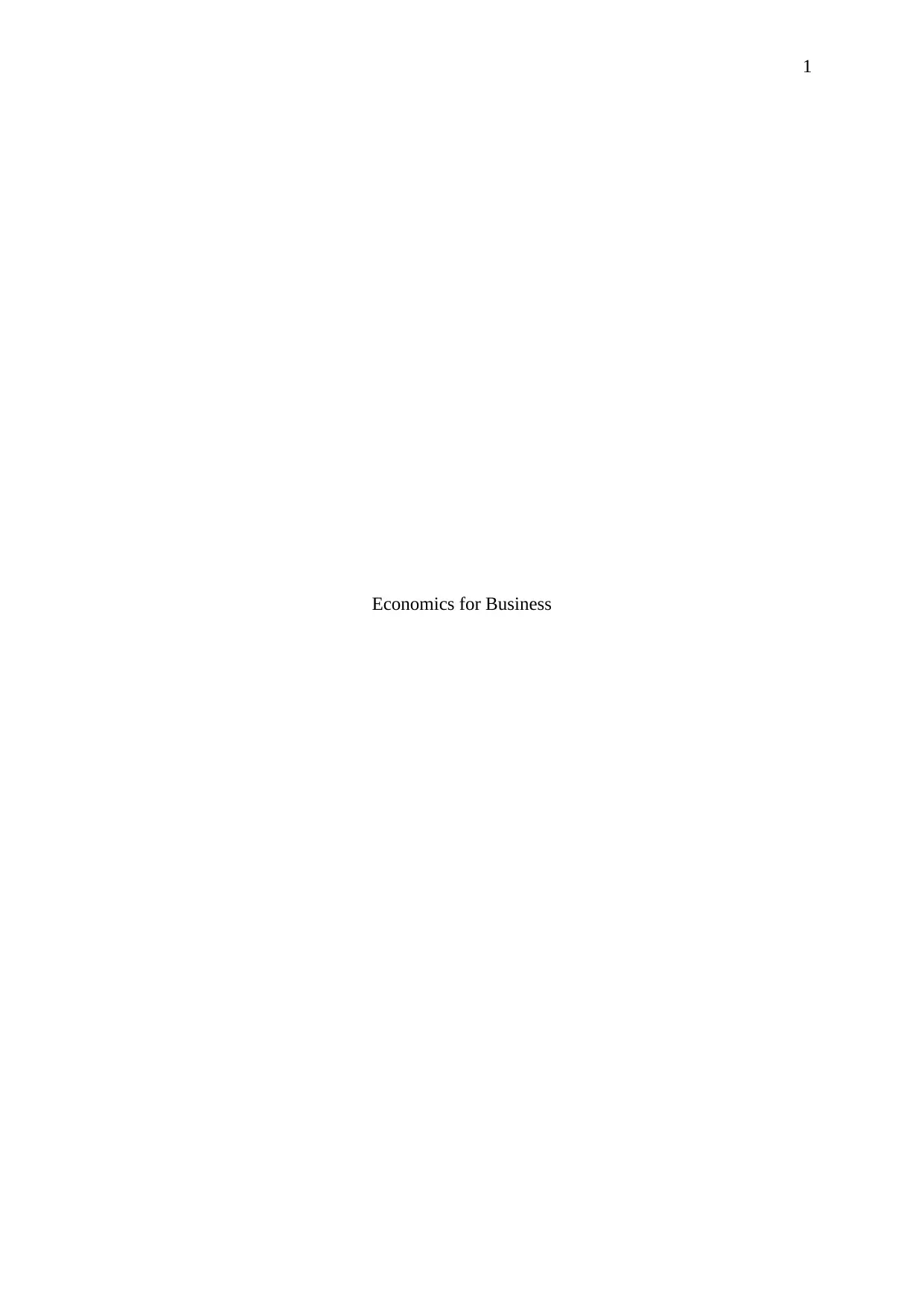
1
Economics for Business
Economics for Business
Paraphrase This Document
Need a fresh take? Get an instant paraphrase of this document with our AI Paraphraser
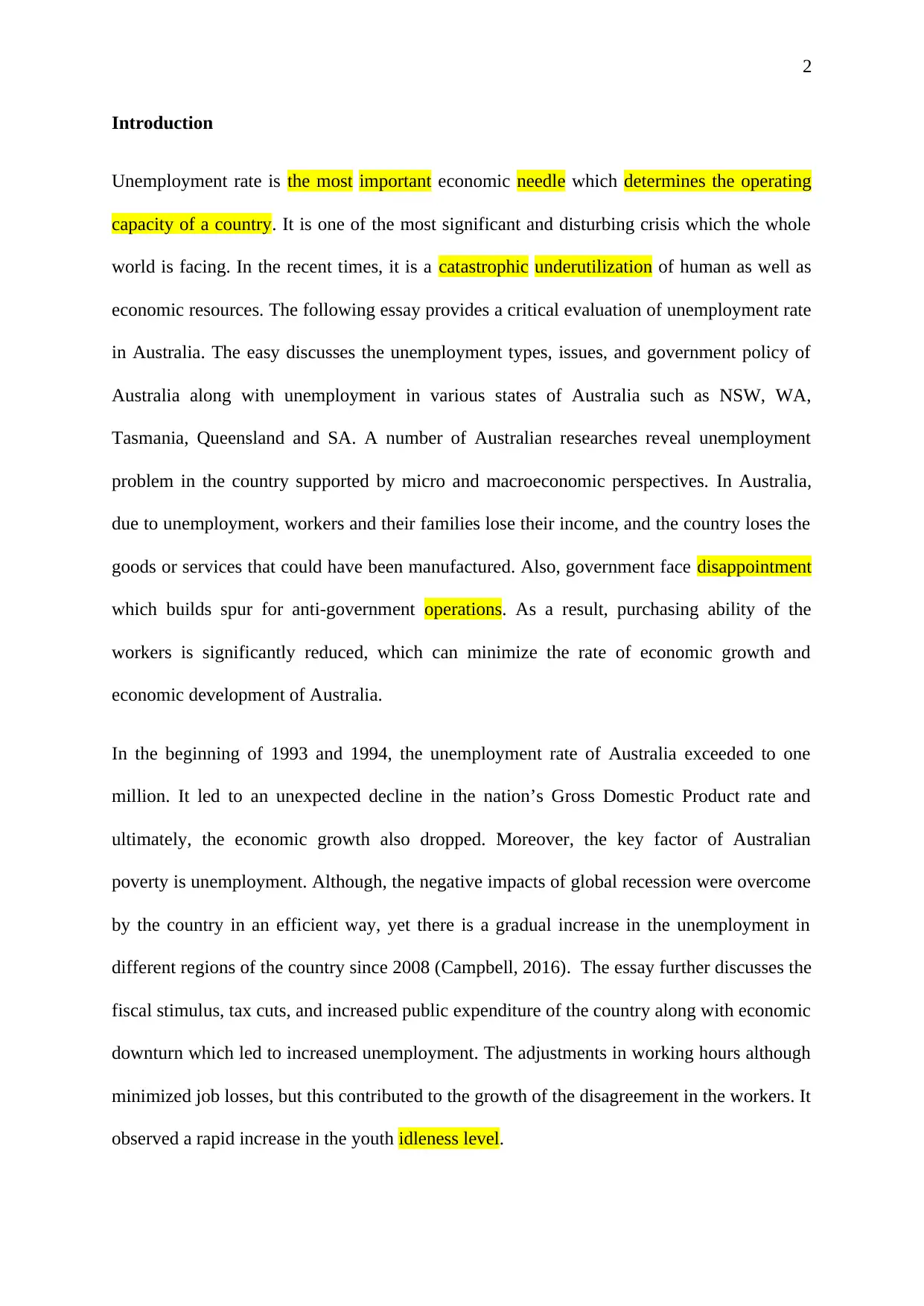
2
Introduction
Unemployment rate is the most important economic needle which determines the operating
capacity of a country. It is one of the most significant and disturbing crisis which the whole
world is facing. In the recent times, it is a catastrophic underutilization of human as well as
economic resources. The following essay provides a critical evaluation of unemployment rate
in Australia. The easy discusses the unemployment types, issues, and government policy of
Australia along with unemployment in various states of Australia such as NSW, WA,
Tasmania, Queensland and SA. A number of Australian researches reveal unemployment
problem in the country supported by micro and macroeconomic perspectives. In Australia,
due to unemployment, workers and their families lose their income, and the country loses the
goods or services that could have been manufactured. Also, government face disappointment
which builds spur for anti-government operations. As a result, purchasing ability of the
workers is significantly reduced, which can minimize the rate of economic growth and
economic development of Australia.
In the beginning of 1993 and 1994, the unemployment rate of Australia exceeded to one
million. It led to an unexpected decline in the nation’s Gross Domestic Product rate and
ultimately, the economic growth also dropped. Moreover, the key factor of Australian
poverty is unemployment. Although, the negative impacts of global recession were overcome
by the country in an efficient way, yet there is a gradual increase in the unemployment in
different regions of the country since 2008 (Campbell, 2016). The essay further discusses the
fiscal stimulus, tax cuts, and increased public expenditure of the country along with economic
downturn which led to increased unemployment. The adjustments in working hours although
minimized job losses, but this contributed to the growth of the disagreement in the workers. It
observed a rapid increase in the youth idleness level.
Introduction
Unemployment rate is the most important economic needle which determines the operating
capacity of a country. It is one of the most significant and disturbing crisis which the whole
world is facing. In the recent times, it is a catastrophic underutilization of human as well as
economic resources. The following essay provides a critical evaluation of unemployment rate
in Australia. The easy discusses the unemployment types, issues, and government policy of
Australia along with unemployment in various states of Australia such as NSW, WA,
Tasmania, Queensland and SA. A number of Australian researches reveal unemployment
problem in the country supported by micro and macroeconomic perspectives. In Australia,
due to unemployment, workers and their families lose their income, and the country loses the
goods or services that could have been manufactured. Also, government face disappointment
which builds spur for anti-government operations. As a result, purchasing ability of the
workers is significantly reduced, which can minimize the rate of economic growth and
economic development of Australia.
In the beginning of 1993 and 1994, the unemployment rate of Australia exceeded to one
million. It led to an unexpected decline in the nation’s Gross Domestic Product rate and
ultimately, the economic growth also dropped. Moreover, the key factor of Australian
poverty is unemployment. Although, the negative impacts of global recession were overcome
by the country in an efficient way, yet there is a gradual increase in the unemployment in
different regions of the country since 2008 (Campbell, 2016). The essay further discusses the
fiscal stimulus, tax cuts, and increased public expenditure of the country along with economic
downturn which led to increased unemployment. The adjustments in working hours although
minimized job losses, but this contributed to the growth of the disagreement in the workers. It
observed a rapid increase in the youth idleness level.
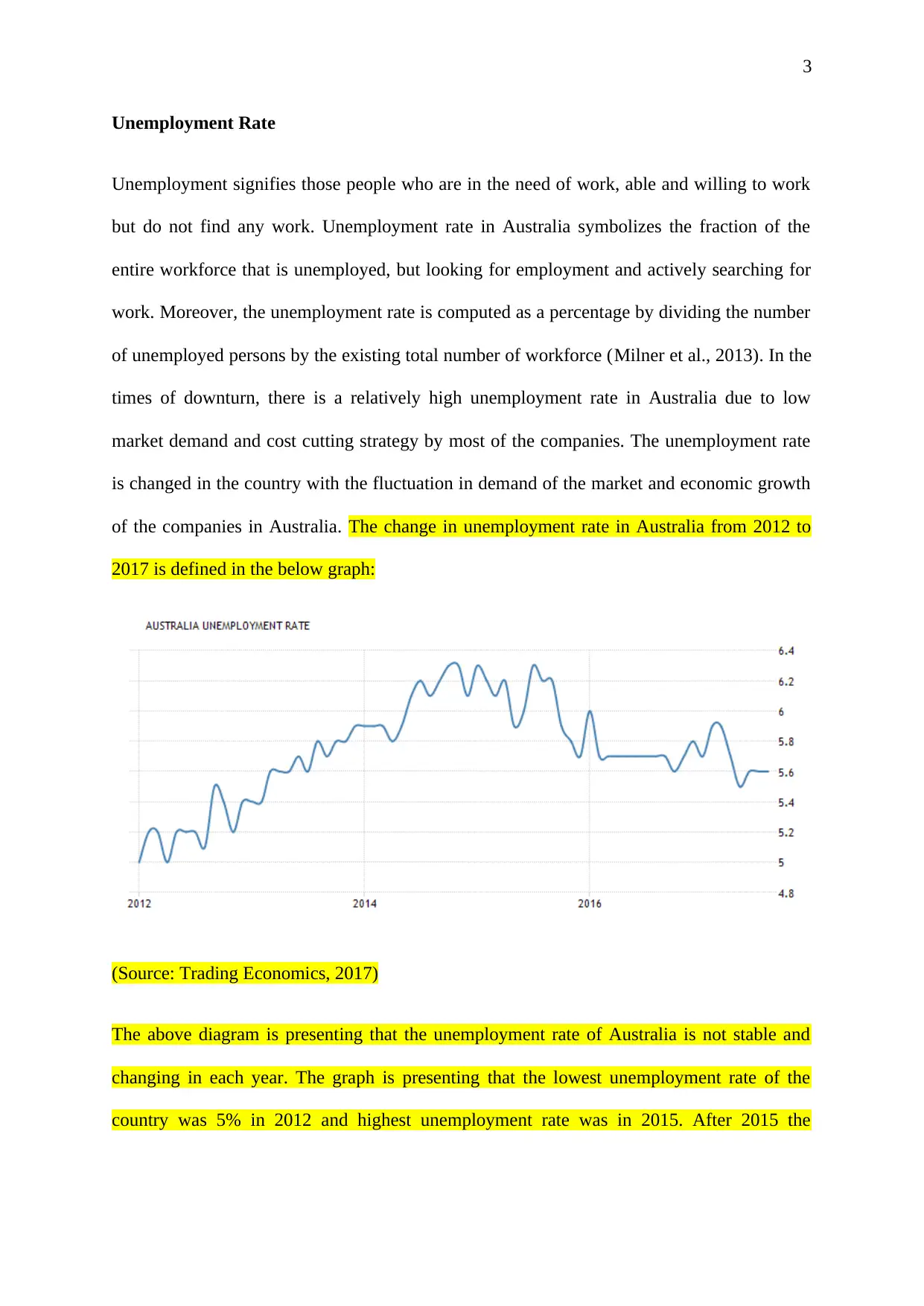
3
Unemployment Rate
Unemployment signifies those people who are in the need of work, able and willing to work
but do not find any work. Unemployment rate in Australia symbolizes the fraction of the
entire workforce that is unemployed, but looking for employment and actively searching for
work. Moreover, the unemployment rate is computed as a percentage by dividing the number
of unemployed persons by the existing total number of workforce (Milner et al., 2013). In the
times of downturn, there is a relatively high unemployment rate in Australia due to low
market demand and cost cutting strategy by most of the companies. The unemployment rate
is changed in the country with the fluctuation in demand of the market and economic growth
of the companies in Australia. The change in unemployment rate in Australia from 2012 to
2017 is defined in the below graph:
(Source: Trading Economics, 2017)
The above diagram is presenting that the unemployment rate of Australia is not stable and
changing in each year. The graph is presenting that the lowest unemployment rate of the
country was 5% in 2012 and highest unemployment rate was in 2015. After 2015 the
Unemployment Rate
Unemployment signifies those people who are in the need of work, able and willing to work
but do not find any work. Unemployment rate in Australia symbolizes the fraction of the
entire workforce that is unemployed, but looking for employment and actively searching for
work. Moreover, the unemployment rate is computed as a percentage by dividing the number
of unemployed persons by the existing total number of workforce (Milner et al., 2013). In the
times of downturn, there is a relatively high unemployment rate in Australia due to low
market demand and cost cutting strategy by most of the companies. The unemployment rate
is changed in the country with the fluctuation in demand of the market and economic growth
of the companies in Australia. The change in unemployment rate in Australia from 2012 to
2017 is defined in the below graph:
(Source: Trading Economics, 2017)
The above diagram is presenting that the unemployment rate of Australia is not stable and
changing in each year. The graph is presenting that the lowest unemployment rate of the
country was 5% in 2012 and highest unemployment rate was in 2015. After 2015 the
⊘ This is a preview!⊘
Do you want full access?
Subscribe today to unlock all pages.

Trusted by 1+ million students worldwide
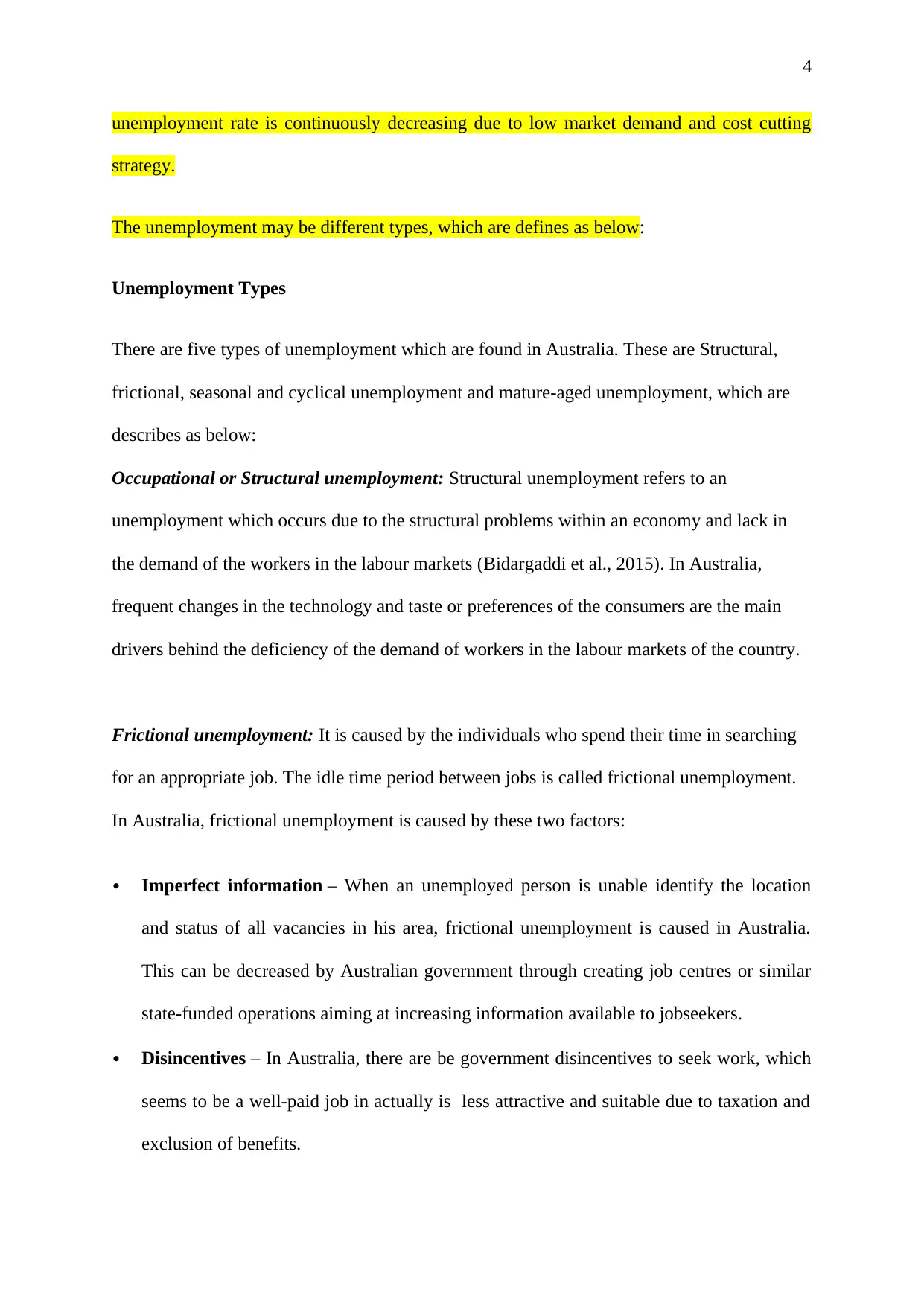
4
unemployment rate is continuously decreasing due to low market demand and cost cutting
strategy.
The unemployment may be different types, which are defines as below:
Unemployment Types
There are five types of unemployment which are found in Australia. These are Structural,
frictional, seasonal and cyclical unemployment and mature-aged unemployment, which are
describes as below:
Occupational or Structural unemployment: Structural unemployment refers to an
unemployment which occurs due to the structural problems within an economy and lack in
the demand of the workers in the labour markets (Bidargaddi et al., 2015). In Australia,
frequent changes in the technology and taste or preferences of the consumers are the main
drivers behind the deficiency of the demand of workers in the labour markets of the country.
Frictional unemployment: It is caused by the individuals who spend their time in searching
for an appropriate job. The idle time period between jobs is called frictional unemployment.
In Australia, frictional unemployment is caused by these two factors:
Imperfect information – When an unemployed person is unable identify the location
and status of all vacancies in his area, frictional unemployment is caused in Australia.
This can be decreased by Australian government through creating job centres or similar
state-funded operations aiming at increasing information available to jobseekers.
Disincentives – In Australia, there are be government disincentives to seek work, which
seems to be a well-paid job in actually is less attractive and suitable due to taxation and
exclusion of benefits.
unemployment rate is continuously decreasing due to low market demand and cost cutting
strategy.
The unemployment may be different types, which are defines as below:
Unemployment Types
There are five types of unemployment which are found in Australia. These are Structural,
frictional, seasonal and cyclical unemployment and mature-aged unemployment, which are
describes as below:
Occupational or Structural unemployment: Structural unemployment refers to an
unemployment which occurs due to the structural problems within an economy and lack in
the demand of the workers in the labour markets (Bidargaddi et al., 2015). In Australia,
frequent changes in the technology and taste or preferences of the consumers are the main
drivers behind the deficiency of the demand of workers in the labour markets of the country.
Frictional unemployment: It is caused by the individuals who spend their time in searching
for an appropriate job. The idle time period between jobs is called frictional unemployment.
In Australia, frictional unemployment is caused by these two factors:
Imperfect information – When an unemployed person is unable identify the location
and status of all vacancies in his area, frictional unemployment is caused in Australia.
This can be decreased by Australian government through creating job centres or similar
state-funded operations aiming at increasing information available to jobseekers.
Disincentives – In Australia, there are be government disincentives to seek work, which
seems to be a well-paid job in actually is less attractive and suitable due to taxation and
exclusion of benefits.
Paraphrase This Document
Need a fresh take? Get an instant paraphrase of this document with our AI Paraphraser
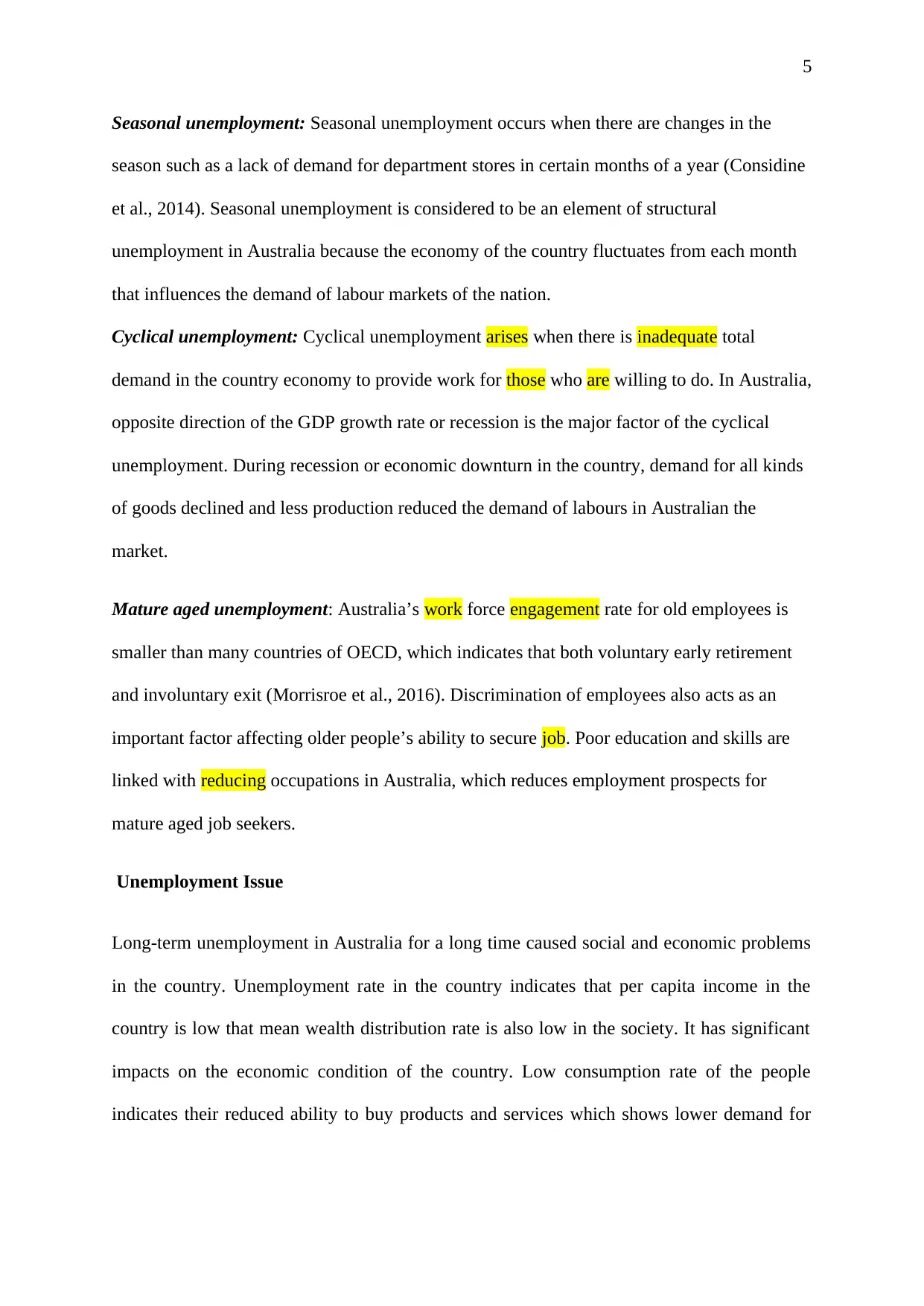
5
Seasonal unemployment: Seasonal unemployment occurs when there are changes in the
season such as a lack of demand for department stores in certain months of a year (Considine
et al., 2014). Seasonal unemployment is considered to be an element of structural
unemployment in Australia because the economy of the country fluctuates from each month
that influences the demand of labour markets of the nation.
Cyclical unemployment: Cyclical unemployment arises when there is inadequate total
demand in the country economy to provide work for those who are willing to do. In Australia,
opposite direction of the GDP growth rate or recession is the major factor of the cyclical
unemployment. During recession or economic downturn in the country, demand for all kinds
of goods declined and less production reduced the demand of labours in Australian the
market.
Mature aged unemployment: Australia’s work force engagement rate for old employees is
smaller than many countries of OECD, which indicates that both voluntary early retirement
and involuntary exit (Morrisroe et al., 2016). Discrimination of employees also acts as an
important factor affecting older people’s ability to secure job. Poor education and skills are
linked with reducing occupations in Australia, which reduces employment prospects for
mature aged job seekers.
Unemployment Issue
Long-term unemployment in Australia for a long time caused social and economic problems
in the country. Unemployment rate in the country indicates that per capita income in the
country is low that mean wealth distribution rate is also low in the society. It has significant
impacts on the economic condition of the country. Low consumption rate of the people
indicates their reduced ability to buy products and services which shows lower demand for
Seasonal unemployment: Seasonal unemployment occurs when there are changes in the
season such as a lack of demand for department stores in certain months of a year (Considine
et al., 2014). Seasonal unemployment is considered to be an element of structural
unemployment in Australia because the economy of the country fluctuates from each month
that influences the demand of labour markets of the nation.
Cyclical unemployment: Cyclical unemployment arises when there is inadequate total
demand in the country economy to provide work for those who are willing to do. In Australia,
opposite direction of the GDP growth rate or recession is the major factor of the cyclical
unemployment. During recession or economic downturn in the country, demand for all kinds
of goods declined and less production reduced the demand of labours in Australian the
market.
Mature aged unemployment: Australia’s work force engagement rate for old employees is
smaller than many countries of OECD, which indicates that both voluntary early retirement
and involuntary exit (Morrisroe et al., 2016). Discrimination of employees also acts as an
important factor affecting older people’s ability to secure job. Poor education and skills are
linked with reducing occupations in Australia, which reduces employment prospects for
mature aged job seekers.
Unemployment Issue
Long-term unemployment in Australia for a long time caused social and economic problems
in the country. Unemployment rate in the country indicates that per capita income in the
country is low that mean wealth distribution rate is also low in the society. It has significant
impacts on the economic condition of the country. Low consumption rate of the people
indicates their reduced ability to buy products and services which shows lower demand for
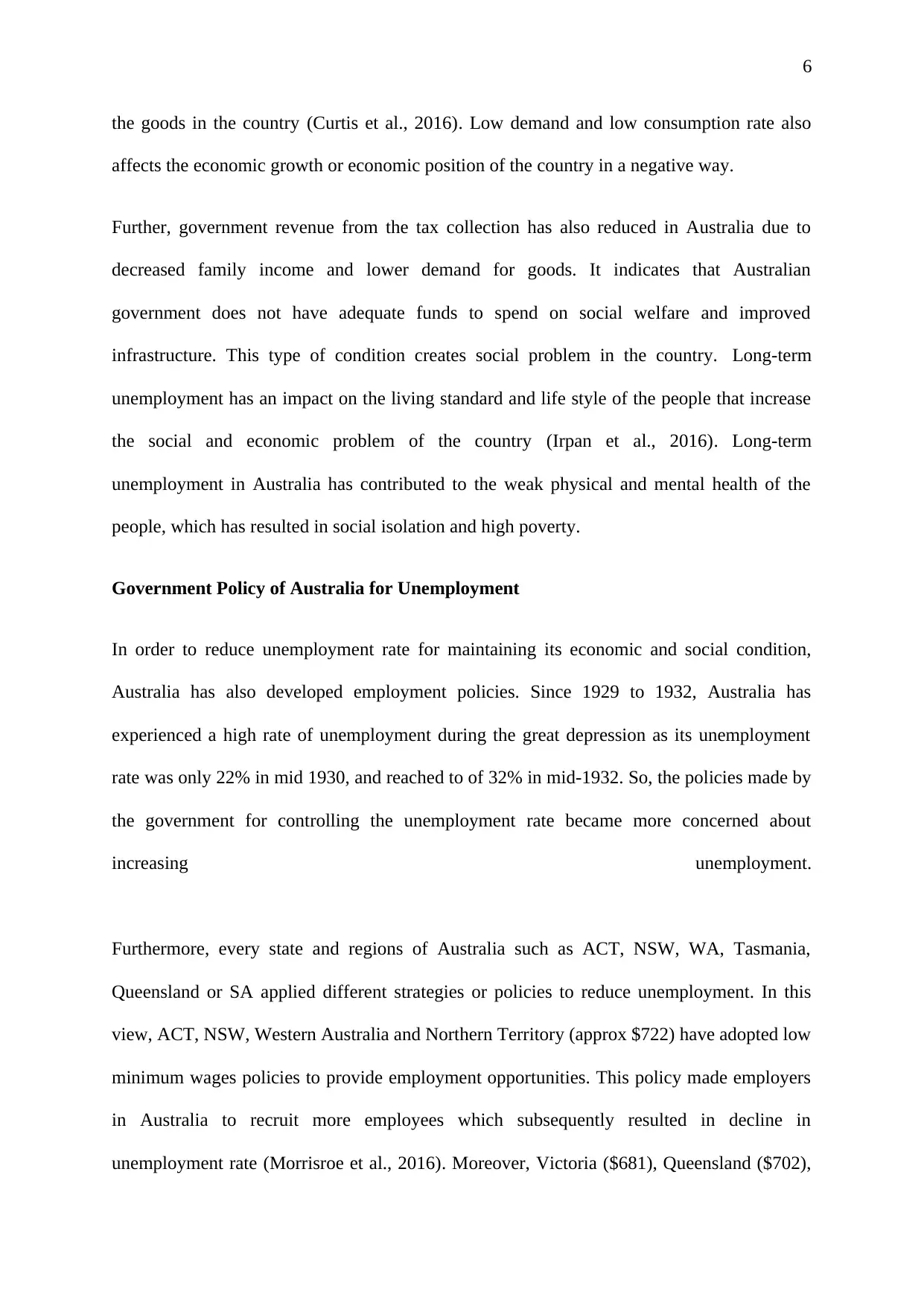
6
the goods in the country (Curtis et al., 2016). Low demand and low consumption rate also
affects the economic growth or economic position of the country in a negative way.
Further, government revenue from the tax collection has also reduced in Australia due to
decreased family income and lower demand for goods. It indicates that Australian
government does not have adequate funds to spend on social welfare and improved
infrastructure. This type of condition creates social problem in the country. Long-term
unemployment has an impact on the living standard and life style of the people that increase
the social and economic problem of the country (Irpan et al., 2016). Long-term
unemployment in Australia has contributed to the weak physical and mental health of the
people, which has resulted in social isolation and high poverty.
Government Policy of Australia for Unemployment
In order to reduce unemployment rate for maintaining its economic and social condition,
Australia has also developed employment policies. Since 1929 to 1932, Australia has
experienced a high rate of unemployment during the great depression as its unemployment
rate was only 22% in mid 1930, and reached to of 32% in mid-1932. So, the policies made by
the government for controlling the unemployment rate became more concerned about
increasing unemployment.
Furthermore, every state and regions of Australia such as ACT, NSW, WA, Tasmania,
Queensland or SA applied different strategies or policies to reduce unemployment. In this
view, ACT, NSW, Western Australia and Northern Territory (approx $722) have adopted low
minimum wages policies to provide employment opportunities. This policy made employers
in Australia to recruit more employees which subsequently resulted in decline in
unemployment rate (Morrisroe et al., 2016). Moreover, Victoria ($681), Queensland ($702),
the goods in the country (Curtis et al., 2016). Low demand and low consumption rate also
affects the economic growth or economic position of the country in a negative way.
Further, government revenue from the tax collection has also reduced in Australia due to
decreased family income and lower demand for goods. It indicates that Australian
government does not have adequate funds to spend on social welfare and improved
infrastructure. This type of condition creates social problem in the country. Long-term
unemployment has an impact on the living standard and life style of the people that increase
the social and economic problem of the country (Irpan et al., 2016). Long-term
unemployment in Australia has contributed to the weak physical and mental health of the
people, which has resulted in social isolation and high poverty.
Government Policy of Australia for Unemployment
In order to reduce unemployment rate for maintaining its economic and social condition,
Australia has also developed employment policies. Since 1929 to 1932, Australia has
experienced a high rate of unemployment during the great depression as its unemployment
rate was only 22% in mid 1930, and reached to of 32% in mid-1932. So, the policies made by
the government for controlling the unemployment rate became more concerned about
increasing unemployment.
Furthermore, every state and regions of Australia such as ACT, NSW, WA, Tasmania,
Queensland or SA applied different strategies or policies to reduce unemployment. In this
view, ACT, NSW, Western Australia and Northern Territory (approx $722) have adopted low
minimum wages policies to provide employment opportunities. This policy made employers
in Australia to recruit more employees which subsequently resulted in decline in
unemployment rate (Morrisroe et al., 2016). Moreover, Victoria ($681), Queensland ($702),
⊘ This is a preview!⊘
Do you want full access?
Subscribe today to unlock all pages.

Trusted by 1+ million students worldwide
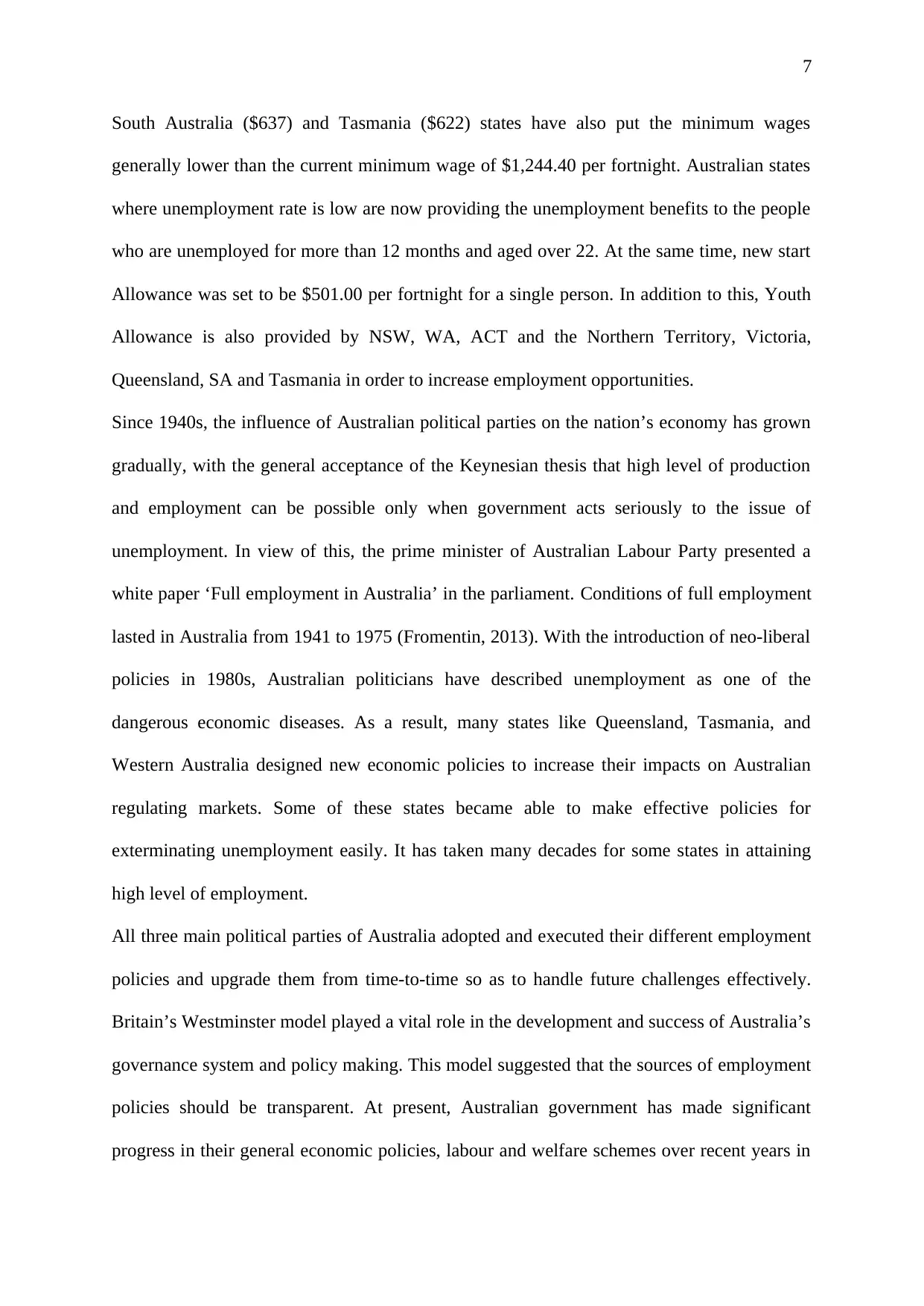
7
South Australia ($637) and Tasmania ($622) states have also put the minimum wages
generally lower than the current minimum wage of $1,244.40 per fortnight. Australian states
where unemployment rate is low are now providing the unemployment benefits to the people
who are unemployed for more than 12 months and aged over 22. At the same time, new start
Allowance was set to be $501.00 per fortnight for a single person. In addition to this, Youth
Allowance is also provided by NSW, WA, ACT and the Northern Territory, Victoria,
Queensland, SA and Tasmania in order to increase employment opportunities.
Since 1940s, the influence of Australian political parties on the nation’s economy has grown
gradually, with the general acceptance of the Keynesian thesis that high level of production
and employment can be possible only when government acts seriously to the issue of
unemployment. In view of this, the prime minister of Australian Labour Party presented a
white paper ‘Full employment in Australia’ in the parliament. Conditions of full employment
lasted in Australia from 1941 to 1975 (Fromentin, 2013). With the introduction of neo-liberal
policies in 1980s, Australian politicians have described unemployment as one of the
dangerous economic diseases. As a result, many states like Queensland, Tasmania, and
Western Australia designed new economic policies to increase their impacts on Australian
regulating markets. Some of these states became able to make effective policies for
exterminating unemployment easily. It has taken many decades for some states in attaining
high level of employment.
All three main political parties of Australia adopted and executed their different employment
policies and upgrade them from time-to-time so as to handle future challenges effectively.
Britain’s Westminster model played a vital role in the development and success of Australia’s
governance system and policy making. This model suggested that the sources of employment
policies should be transparent. At present, Australian government has made significant
progress in their general economic policies, labour and welfare schemes over recent years in
South Australia ($637) and Tasmania ($622) states have also put the minimum wages
generally lower than the current minimum wage of $1,244.40 per fortnight. Australian states
where unemployment rate is low are now providing the unemployment benefits to the people
who are unemployed for more than 12 months and aged over 22. At the same time, new start
Allowance was set to be $501.00 per fortnight for a single person. In addition to this, Youth
Allowance is also provided by NSW, WA, ACT and the Northern Territory, Victoria,
Queensland, SA and Tasmania in order to increase employment opportunities.
Since 1940s, the influence of Australian political parties on the nation’s economy has grown
gradually, with the general acceptance of the Keynesian thesis that high level of production
and employment can be possible only when government acts seriously to the issue of
unemployment. In view of this, the prime minister of Australian Labour Party presented a
white paper ‘Full employment in Australia’ in the parliament. Conditions of full employment
lasted in Australia from 1941 to 1975 (Fromentin, 2013). With the introduction of neo-liberal
policies in 1980s, Australian politicians have described unemployment as one of the
dangerous economic diseases. As a result, many states like Queensland, Tasmania, and
Western Australia designed new economic policies to increase their impacts on Australian
regulating markets. Some of these states became able to make effective policies for
exterminating unemployment easily. It has taken many decades for some states in attaining
high level of employment.
All three main political parties of Australia adopted and executed their different employment
policies and upgrade them from time-to-time so as to handle future challenges effectively.
Britain’s Westminster model played a vital role in the development and success of Australia’s
governance system and policy making. This model suggested that the sources of employment
policies should be transparent. At present, Australian government has made significant
progress in their general economic policies, labour and welfare schemes over recent years in
Paraphrase This Document
Need a fresh take? Get an instant paraphrase of this document with our AI Paraphraser
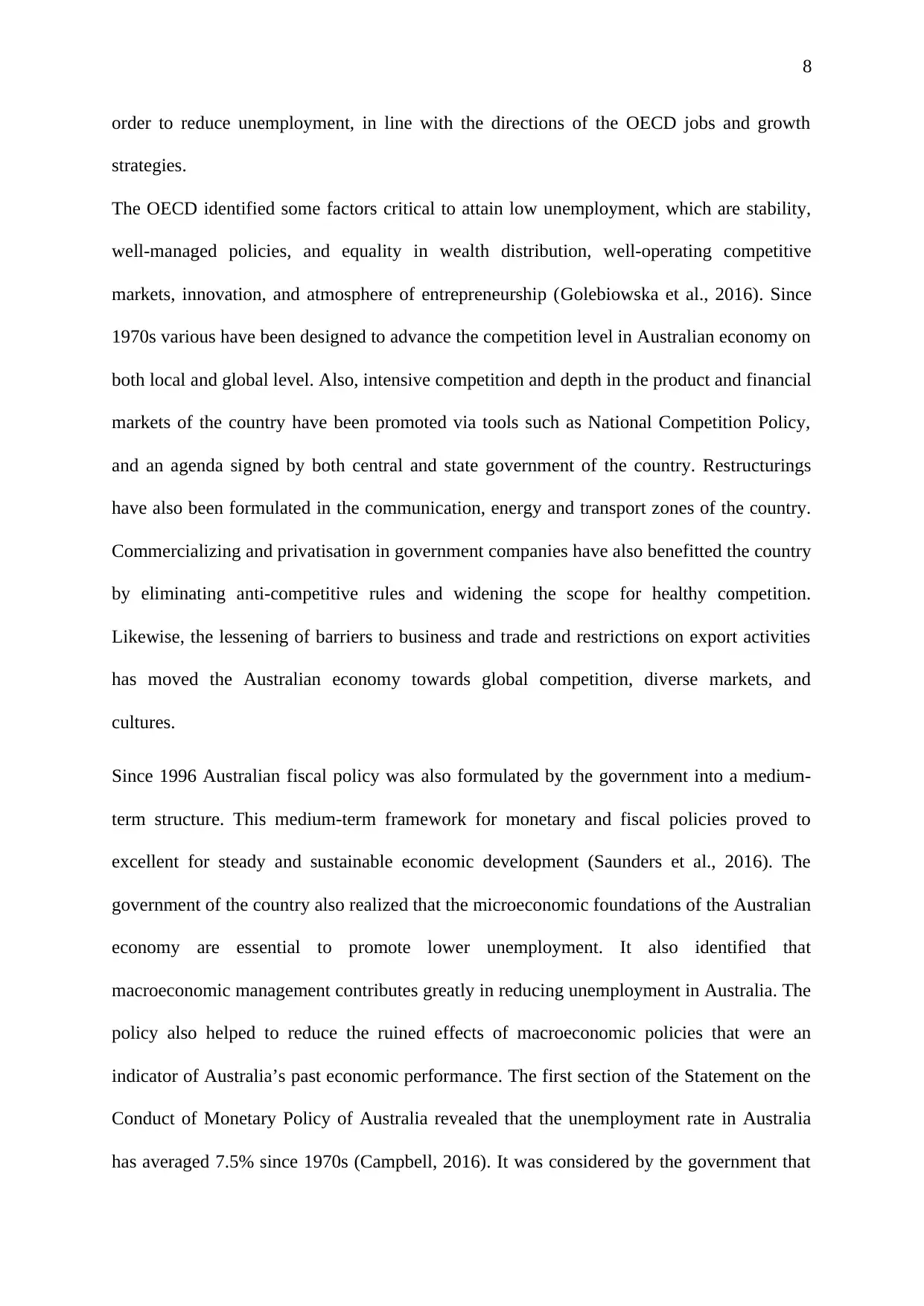
8
order to reduce unemployment, in line with the directions of the OECD jobs and growth
strategies.
The OECD identified some factors critical to attain low unemployment, which are stability,
well-managed policies, and equality in wealth distribution, well-operating competitive
markets, innovation, and atmosphere of entrepreneurship (Golebiowska et al., 2016). Since
1970s various have been designed to advance the competition level in Australian economy on
both local and global level. Also, intensive competition and depth in the product and financial
markets of the country have been promoted via tools such as National Competition Policy,
and an agenda signed by both central and state government of the country. Restructurings
have also been formulated in the communication, energy and transport zones of the country.
Commercializing and privatisation in government companies have also benefitted the country
by eliminating anti-competitive rules and widening the scope for healthy competition.
Likewise, the lessening of barriers to business and trade and restrictions on export activities
has moved the Australian economy towards global competition, diverse markets, and
cultures.
Since 1996 Australian fiscal policy was also formulated by the government into a medium-
term structure. This medium-term framework for monetary and fiscal policies proved to
excellent for steady and sustainable economic development (Saunders et al., 2016). The
government of the country also realized that the microeconomic foundations of the Australian
economy are essential to promote lower unemployment. It also identified that
macroeconomic management contributes greatly in reducing unemployment in Australia. The
policy also helped to reduce the ruined effects of macroeconomic policies that were an
indicator of Australia’s past economic performance. The first section of the Statement on the
Conduct of Monetary Policy of Australia revealed that the unemployment rate in Australia
has averaged 7.5% since 1970s (Campbell, 2016). It was considered by the government that
order to reduce unemployment, in line with the directions of the OECD jobs and growth
strategies.
The OECD identified some factors critical to attain low unemployment, which are stability,
well-managed policies, and equality in wealth distribution, well-operating competitive
markets, innovation, and atmosphere of entrepreneurship (Golebiowska et al., 2016). Since
1970s various have been designed to advance the competition level in Australian economy on
both local and global level. Also, intensive competition and depth in the product and financial
markets of the country have been promoted via tools such as National Competition Policy,
and an agenda signed by both central and state government of the country. Restructurings
have also been formulated in the communication, energy and transport zones of the country.
Commercializing and privatisation in government companies have also benefitted the country
by eliminating anti-competitive rules and widening the scope for healthy competition.
Likewise, the lessening of barriers to business and trade and restrictions on export activities
has moved the Australian economy towards global competition, diverse markets, and
cultures.
Since 1996 Australian fiscal policy was also formulated by the government into a medium-
term structure. This medium-term framework for monetary and fiscal policies proved to
excellent for steady and sustainable economic development (Saunders et al., 2016). The
government of the country also realized that the microeconomic foundations of the Australian
economy are essential to promote lower unemployment. It also identified that
macroeconomic management contributes greatly in reducing unemployment in Australia. The
policy also helped to reduce the ruined effects of macroeconomic policies that were an
indicator of Australia’s past economic performance. The first section of the Statement on the
Conduct of Monetary Policy of Australia revealed that the unemployment rate in Australia
has averaged 7.5% since 1970s (Campbell, 2016). It was considered by the government that
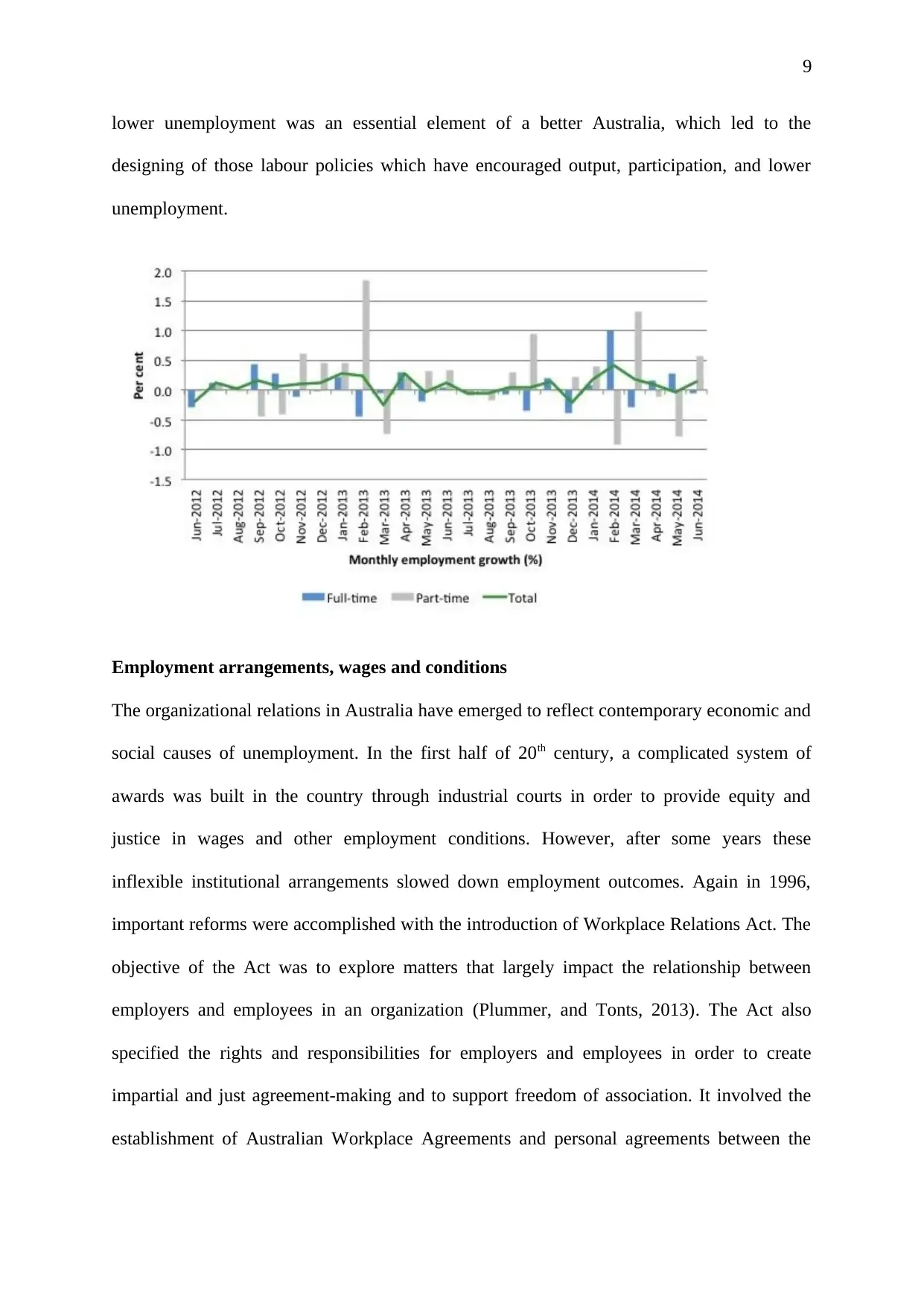
9
lower unemployment was an essential element of a better Australia, which led to the
designing of those labour policies which have encouraged output, participation, and lower
unemployment.
Employment arrangements, wages and conditions
The organizational relations in Australia have emerged to reflect contemporary economic and
social causes of unemployment. In the first half of 20th century, a complicated system of
awards was built in the country through industrial courts in order to provide equity and
justice in wages and other employment conditions. However, after some years these
inflexible institutional arrangements slowed down employment outcomes. Again in 1996,
important reforms were accomplished with the introduction of Workplace Relations Act. The
objective of the Act was to explore matters that largely impact the relationship between
employers and employees in an organization (Plummer, and Tonts, 2013). The Act also
specified the rights and responsibilities for employers and employees in order to create
impartial and just agreement-making and to support freedom of association. It involved the
establishment of Australian Workplace Agreements and personal agreements between the
lower unemployment was an essential element of a better Australia, which led to the
designing of those labour policies which have encouraged output, participation, and lower
unemployment.
Employment arrangements, wages and conditions
The organizational relations in Australia have emerged to reflect contemporary economic and
social causes of unemployment. In the first half of 20th century, a complicated system of
awards was built in the country through industrial courts in order to provide equity and
justice in wages and other employment conditions. However, after some years these
inflexible institutional arrangements slowed down employment outcomes. Again in 1996,
important reforms were accomplished with the introduction of Workplace Relations Act. The
objective of the Act was to explore matters that largely impact the relationship between
employers and employees in an organization (Plummer, and Tonts, 2013). The Act also
specified the rights and responsibilities for employers and employees in order to create
impartial and just agreement-making and to support freedom of association. It involved the
establishment of Australian Workplace Agreements and personal agreements between the
⊘ This is a preview!⊘
Do you want full access?
Subscribe today to unlock all pages.

Trusted by 1+ million students worldwide
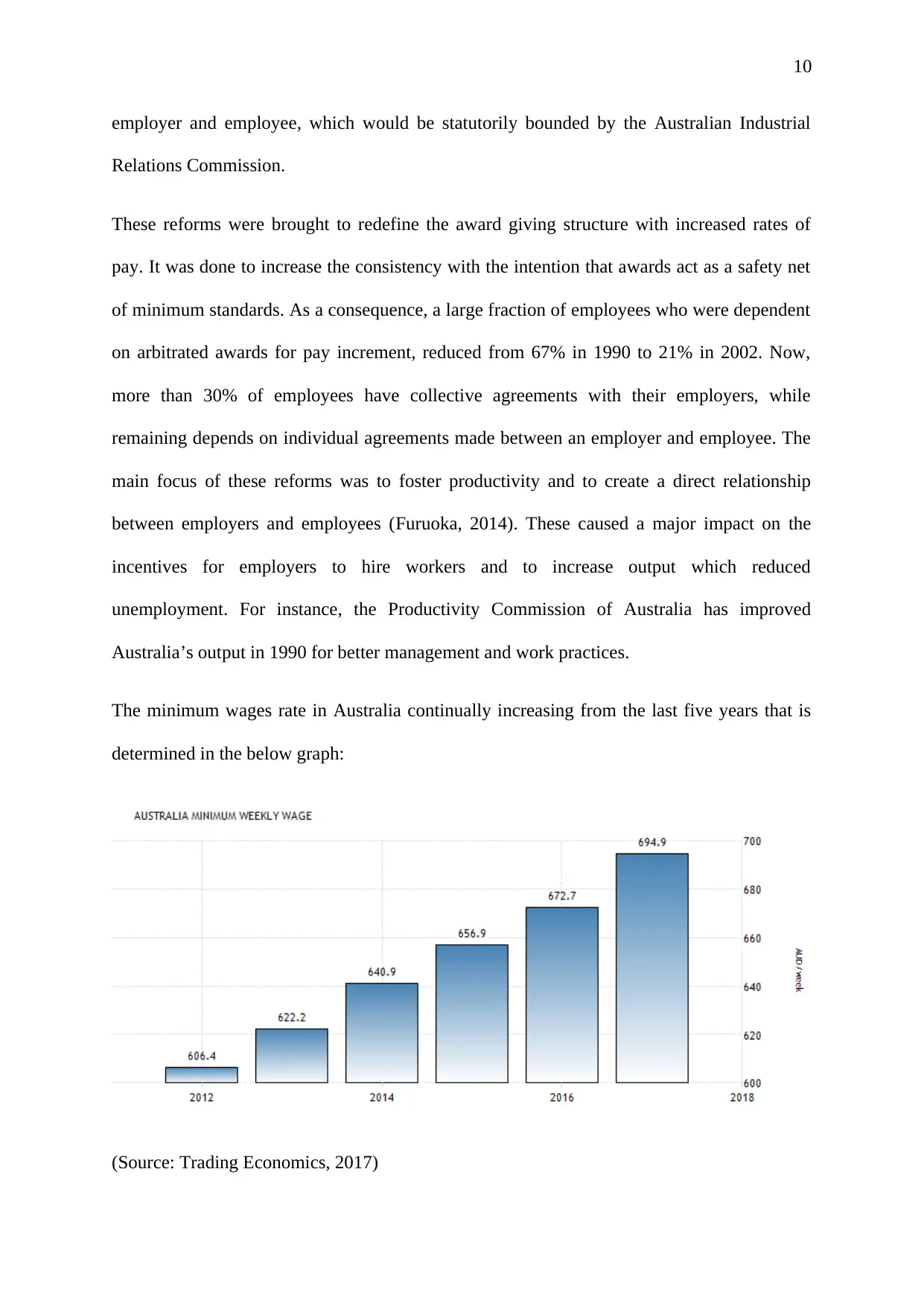
10
employer and employee, which would be statutorily bounded by the Australian Industrial
Relations Commission.
These reforms were brought to redefine the award giving structure with increased rates of
pay. It was done to increase the consistency with the intention that awards act as a safety net
of minimum standards. As a consequence, a large fraction of employees who were dependent
on arbitrated awards for pay increment, reduced from 67% in 1990 to 21% in 2002. Now,
more than 30% of employees have collective agreements with their employers, while
remaining depends on individual agreements made between an employer and employee. The
main focus of these reforms was to foster productivity and to create a direct relationship
between employers and employees (Furuoka, 2014). These caused a major impact on the
incentives for employers to hire workers and to increase output which reduced
unemployment. For instance, the Productivity Commission of Australia has improved
Australia’s output in 1990 for better management and work practices.
The minimum wages rate in Australia continually increasing from the last five years that is
determined in the below graph:
(Source: Trading Economics, 2017)
employer and employee, which would be statutorily bounded by the Australian Industrial
Relations Commission.
These reforms were brought to redefine the award giving structure with increased rates of
pay. It was done to increase the consistency with the intention that awards act as a safety net
of minimum standards. As a consequence, a large fraction of employees who were dependent
on arbitrated awards for pay increment, reduced from 67% in 1990 to 21% in 2002. Now,
more than 30% of employees have collective agreements with their employers, while
remaining depends on individual agreements made between an employer and employee. The
main focus of these reforms was to foster productivity and to create a direct relationship
between employers and employees (Furuoka, 2014). These caused a major impact on the
incentives for employers to hire workers and to increase output which reduced
unemployment. For instance, the Productivity Commission of Australia has improved
Australia’s output in 1990 for better management and work practices.
The minimum wages rate in Australia continually increasing from the last five years that is
determined in the below graph:
(Source: Trading Economics, 2017)
Paraphrase This Document
Need a fresh take? Get an instant paraphrase of this document with our AI Paraphraser
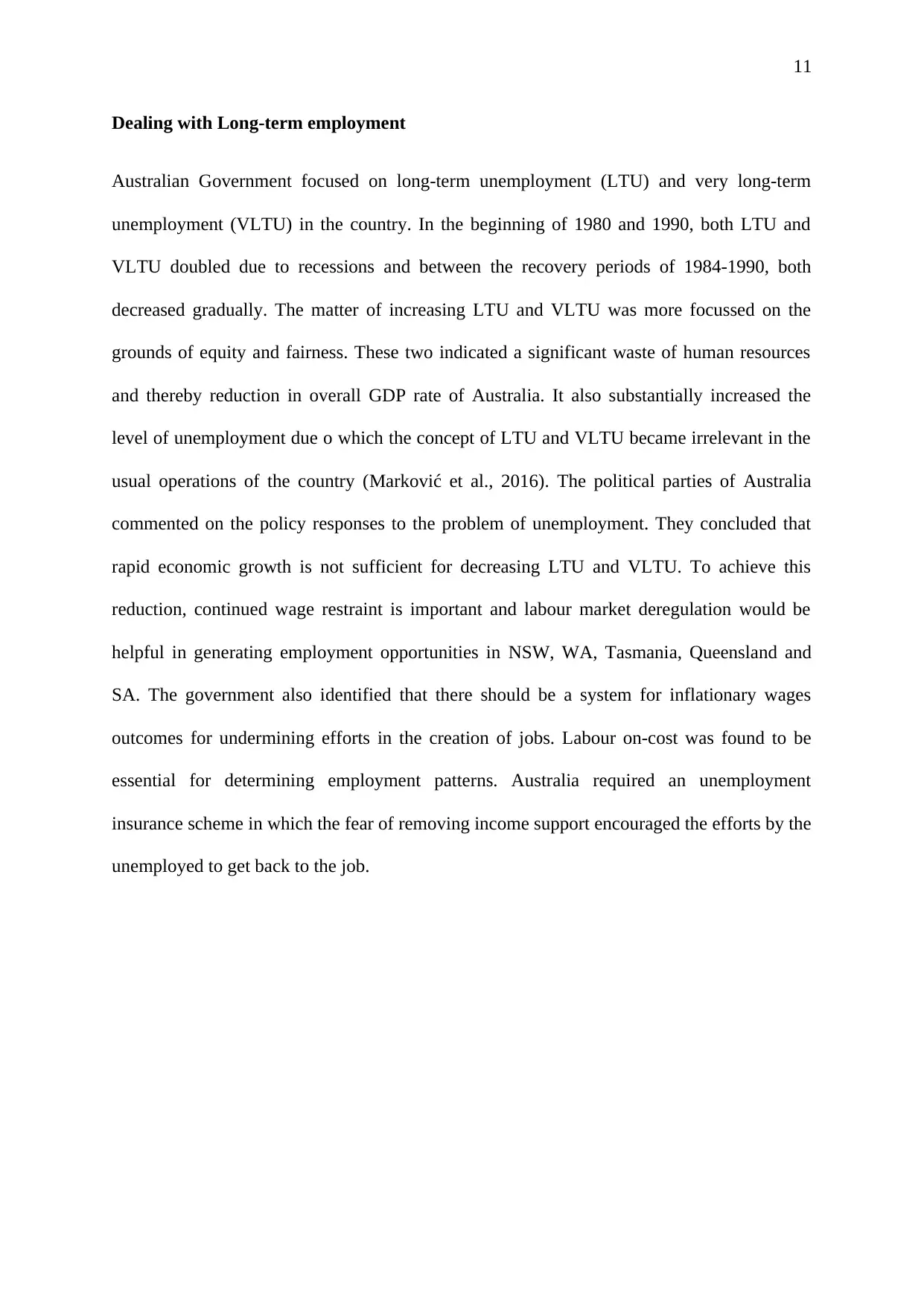
11
Dealing with Long-term employment
Australian Government focused on long-term unemployment (LTU) and very long-term
unemployment (VLTU) in the country. In the beginning of 1980 and 1990, both LTU and
VLTU doubled due to recessions and between the recovery periods of 1984-1990, both
decreased gradually. The matter of increasing LTU and VLTU was more focussed on the
grounds of equity and fairness. These two indicated a significant waste of human resources
and thereby reduction in overall GDP rate of Australia. It also substantially increased the
level of unemployment due o which the concept of LTU and VLTU became irrelevant in the
usual operations of the country (Marković et al., 2016). The political parties of Australia
commented on the policy responses to the problem of unemployment. They concluded that
rapid economic growth is not sufficient for decreasing LTU and VLTU. To achieve this
reduction, continued wage restraint is important and labour market deregulation would be
helpful in generating employment opportunities in NSW, WA, Tasmania, Queensland and
SA. The government also identified that there should be a system for inflationary wages
outcomes for undermining efforts in the creation of jobs. Labour on-cost was found to be
essential for determining employment patterns. Australia required an unemployment
insurance scheme in which the fear of removing income support encouraged the efforts by the
unemployed to get back to the job.
Dealing with Long-term employment
Australian Government focused on long-term unemployment (LTU) and very long-term
unemployment (VLTU) in the country. In the beginning of 1980 and 1990, both LTU and
VLTU doubled due to recessions and between the recovery periods of 1984-1990, both
decreased gradually. The matter of increasing LTU and VLTU was more focussed on the
grounds of equity and fairness. These two indicated a significant waste of human resources
and thereby reduction in overall GDP rate of Australia. It also substantially increased the
level of unemployment due o which the concept of LTU and VLTU became irrelevant in the
usual operations of the country (Marković et al., 2016). The political parties of Australia
commented on the policy responses to the problem of unemployment. They concluded that
rapid economic growth is not sufficient for decreasing LTU and VLTU. To achieve this
reduction, continued wage restraint is important and labour market deregulation would be
helpful in generating employment opportunities in NSW, WA, Tasmania, Queensland and
SA. The government also identified that there should be a system for inflationary wages
outcomes for undermining efforts in the creation of jobs. Labour on-cost was found to be
essential for determining employment patterns. Australia required an unemployment
insurance scheme in which the fear of removing income support encouraged the efforts by the
unemployed to get back to the job.
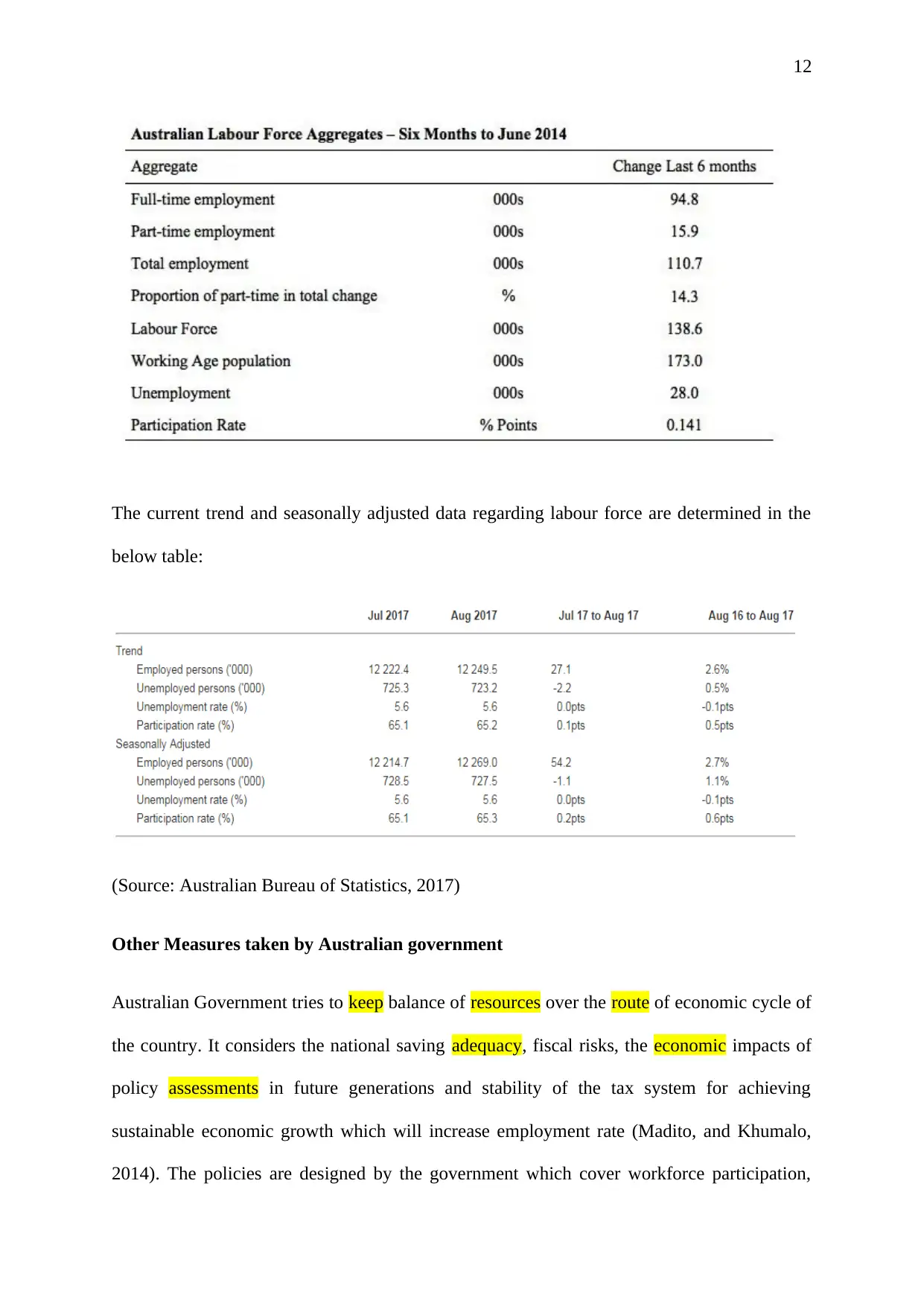
12
The current trend and seasonally adjusted data regarding labour force are determined in the
below table:
(Source: Australian Bureau of Statistics, 2017)
Other Measures taken by Australian government
Australian Government tries to keep balance of resources over the route of economic cycle of
the country. It considers the national saving adequacy, fiscal risks, the economic impacts of
policy assessments in future generations and stability of the tax system for achieving
sustainable economic growth which will increase employment rate (Madito, and Khumalo,
2014). The policies are designed by the government which cover workforce participation,
The current trend and seasonally adjusted data regarding labour force are determined in the
below table:
(Source: Australian Bureau of Statistics, 2017)
Other Measures taken by Australian government
Australian Government tries to keep balance of resources over the route of economic cycle of
the country. It considers the national saving adequacy, fiscal risks, the economic impacts of
policy assessments in future generations and stability of the tax system for achieving
sustainable economic growth which will increase employment rate (Madito, and Khumalo,
2014). The policies are designed by the government which cover workforce participation,
⊘ This is a preview!⊘
Do you want full access?
Subscribe today to unlock all pages.

Trusted by 1+ million students worldwide
1 out of 17
Related Documents
Your All-in-One AI-Powered Toolkit for Academic Success.
+13062052269
info@desklib.com
Available 24*7 on WhatsApp / Email
![[object Object]](/_next/static/media/star-bottom.7253800d.svg)
Unlock your academic potential
Copyright © 2020–2025 A2Z Services. All Rights Reserved. Developed and managed by ZUCOL.




